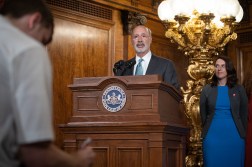Challenges, benefits exist for states looking at ranked-choice voting switch

There are growing questions about the IT implications of the ranked-choice voting system gaining steam around the country, as more states begin to consider making the big electoral change.
Just last month, Maine’s Secretary of State certified a ballot question that will give voters the chance to decide whether to completely overhaul the state’s elections. Ranked-choice voting gives people the chance to rank their favorite candidates in order of preference, rather than just choosing one.
While substantial issues dog the push for ranked-choice voting in Maine, advocates for the change believe that other states should consider backing similar election overhauls.
“Ranked-choice voting has a variety of applications,” Drew Spencer, legal director for the ranked-choice advocacy group FairVote, told StateScoop. “It’s really a pretty simple change that can have a big impact in a variety of different ways.”
Spencer admits that it may not be the right solution for every state, but he believes more may start to seriously examine ranked-choice voting as it gains steam in both Maine and cities around the country.
“A lot of places will be watching, and will be very interested in how it goes and seeing if it would work for their state as well,” Spencer said.
Initial considerations
Before any state considers a move to ranked-choice voting, Spencer urges leaders to consider the “administrative changes” necessary to enable the move.
However, he adds that those necessary shifts can be made without crippling expenses for any state.
The most obvious change involves the ballots themselves, since they’ll now need to accommodate voters listing several choices per race instead of just one. For states still using paper ballots, Spencer notes that his group has “a pretty good sense of what a good, usable optical scan ballot looks like in a ranked-choice voting election” thanks to its work with localities running the new system, making the shift a relatively easy one.
But for states depending mostly on electronic voting machines, he believes the change is even easier.
“Modern voting equipment from all of the major vendors has the ability to run ranked-choice voting elections right now and many of them don’t require any real modifications,” Spencer said.
He added that tabulating results from ranked-choice elections was once difficult due to the “instant runoff” feature of the system — meaning that if no candidate manages more than 50 percent of the vote, the candidate with the fewest votes is eliminated and voters who picked that candidate as their top choice have their votes added to their second choice’s total until a winner emerges. But that issue has largely been resolved by digital tabulators and their specialized counting software.
In cities like San Francisco and Oakland, Spencer noted election officials have even developed customized software to calculate the winners of the elections very quickly.
“You just push a button and you get the election results,” Spencer said.
Spencer added that some free software already exists in open source formats for ranked-choice vote counting, should states want to cut down on costs.
Indeed, one state has already successfully used those kinds of methods to run a ranked-choice election.
North Carolina lessons
When a spot on the North Carolina Court of Appeals opened up due to a judge’s federal appointment in August 2010, there was no time for a proper primary.
With the general election just a few months away, Gary Bartlett, then the director of the state board of elections, had to get creative.
A total of 13 candidates qualified for the ballot, and Bartlett and his team saw ranked-choice voting as the only viable option, even if it meant running the “first statewide ranked-choice voting election since the 1930s.”
Part of what enabled that shift was that it came with “no additional cost with voting equipment,” according to Bartlett. For the state’s electronic voting machines, Bartlett’s office pitched in to write an algorithm that would let them run a ranked-choice question on the ballot.
To test it, they solicited the help of both N.C. State University’s computer science program and their voting machine vendor to take a look at it.
“They both came back and said it worked,” Bartlett said.
For ballots that needed to be hand counted, Bartlett’s team developed a system for sorting the ballots appropriately, and then set about educating election officials across the state about it leading up to November.
Bartlett added that they also worked to educate people about the ranked-choice race with PSAs and media outreach. On election day, he also worked to make sure the people manning the polls walked through voters on the unique system.
“We put in a training step, so that when the person announced themselves at the polls and gave their address and such, we had a person who would show the ballot to them, the normal ballot they’d vote and what was new and showed how that worked,” Bartlett said. “That 10 to 20 seconds cut down on a lot of confusion.”
By the time the election was finished, Bartlett could scarcely believe how smoothly it all ran.
“Going into that election, I was fearing the confusion factor, and I came to find out that really did not bubble up anywhere to the top, it was pretty much a normal election,” Bartlett said. “Were there people saying ‘What? Why are we doing this?’ Of course there were. But it was not to the extent that I was anticipating.”
Bartlett acknowledges that the extra attention generated by a presidential race might’ve made the process more difficult, but overall, he’d recommend it to other states.
“I think that any time you have something new, elections officials are the first to be skittish,” Bartlett said. “The reason why is they have a lot of burden and low budgets, but a little planning and a lot of buy in will make things easy.”
Words of warning
Jason McDaniel, an assistant professor of political science at San Francisco State University, feels that voter outreach is a key component to making ranked-choice voting work.
He notes that his research into San Francisco’s ranked-choice elections in 2007 and 2011 show that the election system can create higher rates of ballot errors because it can be confusing to voters. It can also drive down voter turnout, he warns.
Overall, McDaniel isn’t a proponent of the ranked-choice method, preferring to see more states adopt automatic voter registration to boost turnout numbers. But if states are going to use ranked choice, he thinks they need to do more than just a few PSAs like North Carolina.
“If this is adopted, this should be part of the debate, ‘What resources are the states and counties going to have to bring to bear to make this process work in terms of languages, in terms of outreach, in terms of ballot design?’” McDaniel said. “There needs to be a lot of work as well to bring people along.”
But Spencer feels those outreach efforts would be well worth any state’s efforts, in order to give voters more choices and produce stronger winners.
“As of now, it’s definitely something that’s very doable,” Spencer said.






